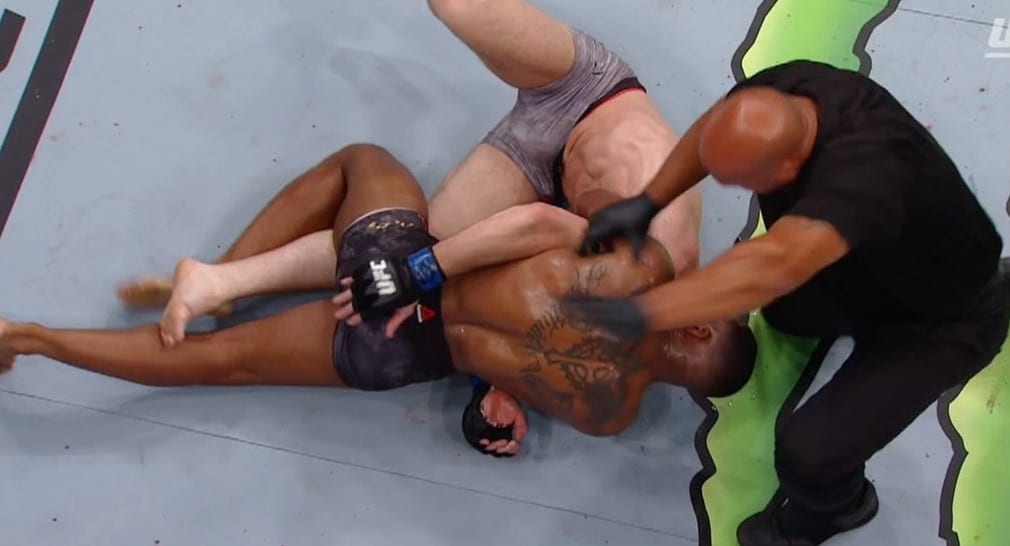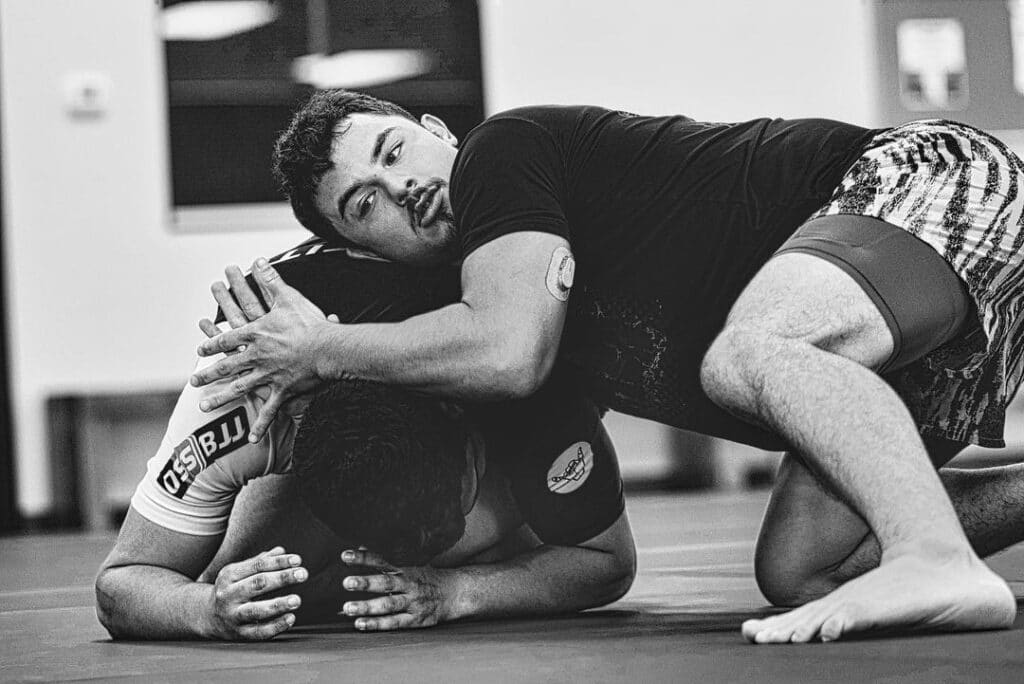D’Arce Choke – BJJ Submission Explained

There’s a series of front headlock chokes with numerous entries you need to know. One that is a phenomenal submission to add to your BJJ game is the d’arce choke.
This is a highly effective choke that you can set up from numerous positions. Whether you’re on top controlling an opponent or on bottom setting a trap, the d’arce choke is there.
If you are thinking about learning a d’arce choke, then you definitely need to read everything about the d’arce below. We’re going to cover when it was created, how it works, and numerous entries into the choke.

Contents
When was the d’arce choke created?
The name d’arce came from American wrestler Joe D’arce that trains at Renzo Gracie’s NYC school. Although a German luta livre fighter named Björn Dag Lagerström may have done it first. But the technique may also precede him since humans have been grappling for centuries.
Either way, a wrestler named Joe D’arce learned the technique from John Danaher at Renzo’s NYC school. At a tournament, BJJ coach Marc Laimon saw D’arce do the technique and dubbed it “the d’arce choke” The name stuck and most everyone in Jiu Jitsu now refers to the move as the d’arce choke.
There is another technique called the brabo choke that Checkmat BJJ founder Leo Vieira created using the Gi. It is the exact same mechanics as the d’arce choke, but you use the opponent’s lapel to choke them.
How does the d’arce choke work?
The d’arce choke works using a mix of your force and your opponent’s own body against them. Much like an arm triangle, where you push the opponent’s arm into their neck to choke them. While at the same time you arm cuts off blood flow to the other side of their neck.
But with the d’arce choke, the grip is reversed and you choke the opponent on their side. Opposite to the arm triangle, where the opponent is choked flat on their back.
As you get control of the opponent’s head and arm, you bend their neck down. Then you lock your grips, get the opponent on their side, and set in the pressure of the choke.
Basic d’arce choke setup
The d’arce choke originally came from the front headlock position with the opponent in turtle. You can get here by either dragging your opponent down or defending their takedown attempt by sprawling.
One you’ve established control of your opponent, you can begin setting up your d’arce. First step is you need to have your chest pressed down on the opponent’s spine. This keeps them in place and puts pressure down on their neck.
Your choke hand is going to go under the opponent’s arm and come out on the other side of their neck. If you need to go deeper, you can do a palm on palm grip to push your arm further out.
You can use this grip to turn the opponent or roll to their side to get in position. Next is the grip setup.
Some schools teach to have your bicep under the opponent’s chin, but the blade of your forearm is better. It is a tighter choke and gives the opponent less space, where they could escape.
With your forearm under their neck, lock your arms together by grabbing your bicep like an RNC grip. Now if you haven’t already got the opponent on their side, put them there to finish the choke.
Squeeze with your body as you push their neck down with your chest. The choke should come on quick and your opponent will either tap or go to sleep.
D’arce choke from sidemount
There’s a really easy d’arce choke setup from top side control with only a few steps. It starts when the opponent goes to recover guard by getting on their side.
When they do this, they bring their arm up in an attempt to get an underhook. This opens themselves up for you to lock in a d’arce choke.
Hook your inside arm under the opponent’s arm until your arm is next to their neck. With your forearm under their chin, get your grips, drop your chest on their head to bend their neck, and squeeze.
Also a little extra tip for all d’arce choke setups. If you want to keep the opponent in place and stop their defense, hook their leg with your leg.
D’arce choke from bottom side control
From bottom side control, there is another d’arce choke you can do. It’s actually a trap, where you fake a side control escape and go for a d’arce.
You start out with framing with your forearm against the opponent’s neck and the other against their hip. With your frames set, you’re going to bait your opponent by bridging into them like you’re trying to recover guard.
Naturally, they’ll push back and when they do hook your inside arm on the other side of their hip. This hook gives you momentum to turn away from the opponent and in place to set up the d’arce.
From here, lock your grips, walk your hips into your opponent, and get the submission.
D’Arce choke top half guard
There’s a nice d’arce choke setup from when you’re in top half guard and your opponent is trying to recover. Usually to recover guard, the reach up to take an underhook.
When they do this, you let them have it and counter with a deep underhook and frame on their head. With the opponent already bent and on their side, you just have to get your grips.
Push their head down, then sink your arm deep under their neck, and get your grips for your d’arce.
D’arce choke open guard
Jeff Glover is a master of the d’arce choke and he has a sneaky setup from open guard. What he does is bait his opponent by turning away from them exposing his side.
If the opponent takes the bait, they will bodylock you and put you on your back. When they do this extend your near arm to the sky and rotate it around their arm. Your other arm is basing on the mat to prevent you from getting tackled to your back.
With your deep underhook, you throw yourself to your back, hook your arm under the opponent’s neck. Just take your grips and finish the d’arce.
Rolling d’arce choke
When you’re on top of your opponent in turtle position, you can roll to multiple front headlock chokes. One in particular is the d’arce choke.
It works really well, when the opponent is tight and you can’t get your arm in. You’re basically going to do a barrel roll to get your choke arm in place for the d’arce.
Dive and roll under your opponent hooking their neck and rolling them to their back or side. It’s a very slick way of setting up your d’arce choke.
Tips for doing the d’arce choke
The d’arce is a dynamic choke, but if one details is off the whole submission falls apart. Here are the tips you need to know to be successful with the d’arce choke.
- Hand Next To The Neck: Remember that a d’arce choke is opposite of an anaconda choke. Your arm goes under their arm and comes out against their neck.
- Choke With Your Forearm: Use the blade of your forearm to choke your opponent. Your bicep can choke them, but the blade of your forearm makes the choke more powerful.
- Chest On Opponent’s Spine: You need to have you chest on top of the opponent’s spine for the d’arce to work. Doing this establishes control over the opponent and adds more pressure on their neck..
- Bend The Neck: Just like with any front headlock choke, you need to bend their neck down. The d’arce won’t work if you don’t do this.
- Control Opponent’s Arm: You need to control the arm you have in your d’arce choke and push it under their neck. Their own arm actually chokes them when you lock on pressure. Pulling it across will also keep them from defending the choke by basing.
- Hand On Bicep Grip: Your grip for the d’arce is the exact same as an RNC grip just from the opposite side.
- Put The Opponent On Their Side: For the d’arce to work, you need to put the opponent on their side. If they stay on all fours it is just a controlling position and won’t choke them. You can get them on their side by either turning them or rolling them.
- Hook Their Leg: This tip is optional, but you can hook the opponent’s leg to keep them in place. It will also close space and give them less room to defend.






